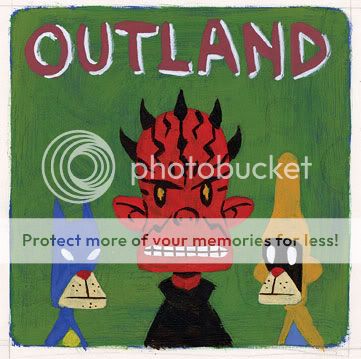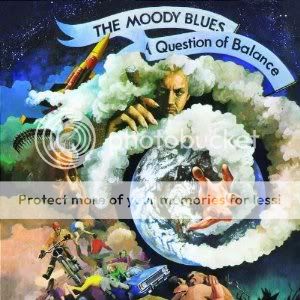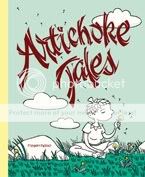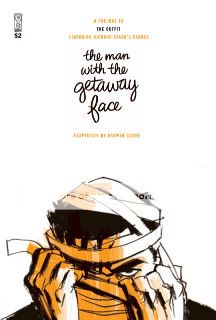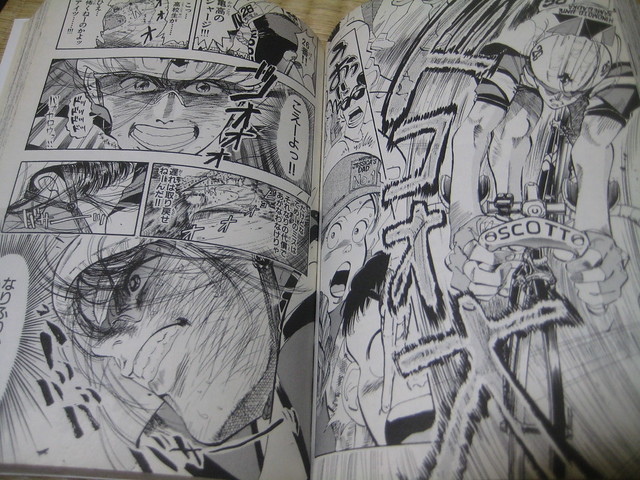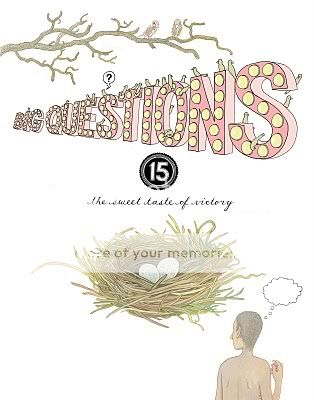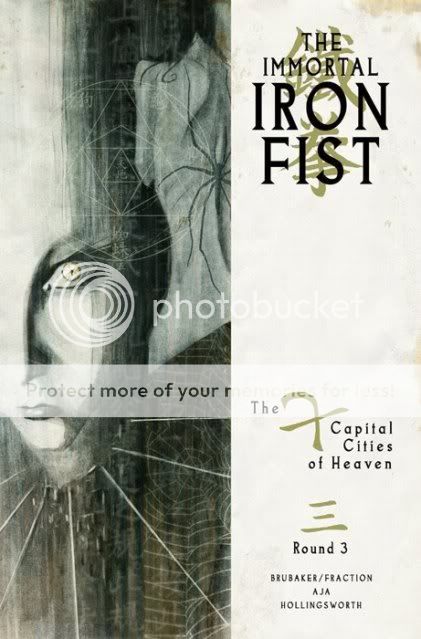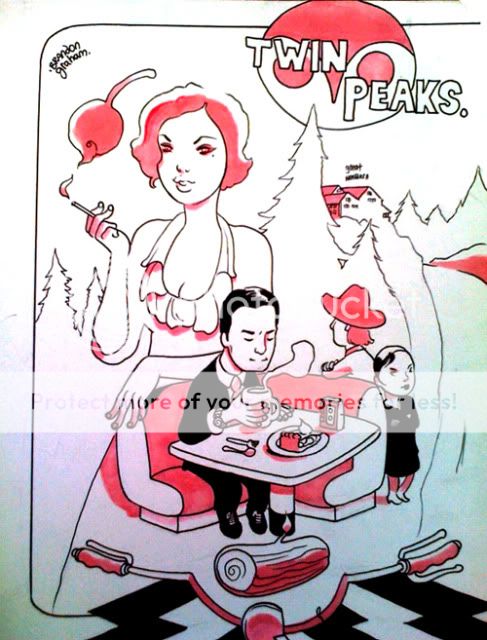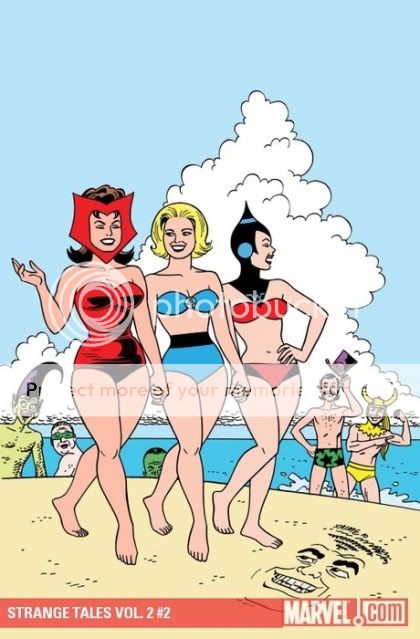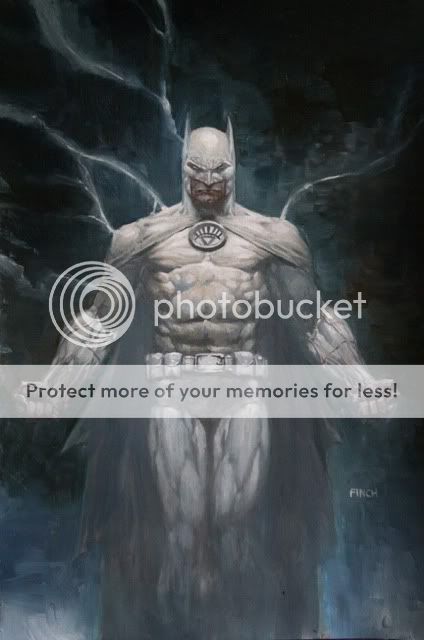Author Archive
Carnival of souls
August 27, 2010* One quick programming note: My review of Scott Pilgrim vs. the World went out over RSS earlier today with a paragraph missing–a whole shpiel about Ramona vs. the Manic Pixie Dream Girl and Scott as Knives’s Manic Pixie Dream Boy–so if you’re interested, please click again to make sure you got the whole thing.
* Recently on Robot 6: A first look at Hope Larson’s A Wrinkle in Time.
* Wait–a new THB issue from Paul Pope and AdHouse? Whaaaat? (Via Tom Spurgeon.)
* Returning to it a couple days later–like flying over a still-gushing oil spill–I find it hard to overstate what a trollish, narcissistic, pointless disgrace the Comics Journal’s roundtable on Ben Schwartz’s Best American Comics Criticism became.
* Speaking of! The programming slate for SPX has been announced. I can’t go this year, and even though this is because of entirely pleasant personal reasons, I’m still bummed out because I’d give my eye teeth to be able to participate in the Critics’ Panel again this year, or even just attend it: Johanna Draper Carlson, Gary Groth, Tim Hodler, Bill Kartalopoulos, Chris Mautner, Joe McCulloch, Ken Parille, and Caroline Small. Sparks really could fly at this thing, and ought to. At the very least, allow me to beg someone to record it! (Via Tom Spurgeon.)
* Here’s a fine David Bordwell essay (is there any other kind?) on coincidence in film narrative. Read the whole thing, just for the pleasure of having done so.
* A lot of people got really excited to see Kevin Huizenga’s story “Time Travelling” go up on Jordan Crane’s webcomics site What Things Do, and I don’t blame them, but mostly it makes me think of how many people I’d kneecap to get Huizenga’s “A Sunset” online. It’s from Or Else #2 and I’m reasonably sure it’s the best short comic story of century so far.
* Jason draws Darth Maul, Batman, and a Teletubby WHOOPS a Moebius character (LOL! thanks Jog), Jason-style.
* Wow, “Always Loved a Film,” the most straightforwardly fun Underworld song ever, now has the most straightforwardly fun Underworld video ever!
* There’s no way to say this without coming across like a complete tool, but since it’s not like it’d be the first time, here goes. Tomorrow is apparently Read Comics in Public Day. I know that everyone’s heart is in the right place, but every day is read comics in public day for me because I’m a grown-up who owns his life choices. It’s no big deal.
Continue Y/Y?
August 27, 2010Scott Pilgrim vs. the World felt natural. Which is an odd thing to say about a romantic comedy punctuated by video-game-style fight scenes the way Grease is punctuated by John Travolta singing, I suppose, but then that’s just how in tune I am with what’s going on with this movie. Watching it simply reinforced that huge eureka moment I had when I first read Bryan Lee O’Malley’s comic and discovered how he’d incorporated the visual and structural language of videogames into a twentysomething slice-of-lifer. Fights, leveling up, people turning into coins when they get defeated, warp zones, 1-ups, ninja swords, sound effects, stats–this stuff has been part of the fabric of my mental life for so long that it’s difficult to describe how simultaneously familiar and thrilling it feels to see it in an everyday kinda context, right there among rock dudes and cute girls and tagalongs and witty slutty gay guys and awkward parties and scenesters and so on and so forth. Of course it should be there!
And it was naturally funny, too. I think one thing that gets lost in discussion of co-writer/director Edgar Wright’s genre send-ups is how much of the humor has little to do with riffing on Night of the Living Dead or Bad Boys or whatever the case may be and stems instead from the effortless interaction of characters who’ve gotten to know each other, play off each other’s insecurities, and draw out each other’s funniest stuff. In that sense Scott has a lot more to do with Shaun of the Dead than with Hot Fuzz in that it’s about a group of young, slightly directionless young people who’ve mostly been friends forever–there’s that same sense of people putting on their roles in the group like a pair of comfortable shoes and kicking around their affection for and annoyance with one another like a soccer ball. So for all the screwball pacing and dialogue it had a…laconic feel to it, I think I wanna say? Like, it was super-easy to slide into the group and laugh at Wallace’s knowingness and Scott’s blithe sleaziness and Julie’s GTFOness and Knives’s head-over-heels-ness and Young Neil’s wannabe-ness and Kim’s grumpiness and Stephen’s panicked ambitiousness Stacey’s annoyingly right-ness and so on and so forth, like we’d known these folks all our lives.
Heck, even the most potentially problematic character in this regard, literal dream girl Ramona, was played pretty much straight–Mary Elizabeth Winstead’s comparatively flat performance vs., well, everyone else in the movie could be seen as a mistake, but to me it was the perfect way to thwart any potential Manic Pixie Dream Girlisms. Indeed, that character comes across like a point-by-point refutation of the MPDG–dry rather than manic, she makes Scott’s life a disaster rather than an adventure, and the only whimsical thing about her, her hair, is treated like a sign of emotional problems and an intimidating obstacle to be overcome. Most importantly, the whole point of the movie is that her life existed in and of itself long before she entered Scott’s. She’s got a long, troubled history and a rich emotional life–she’s an agent, not an object. If anything, it’s Scott who’s Knives Chau’s Manic Pixie Dream Boy, transforming her life into a swoony spectacular with his carefree indie-rock lifestyle and heretofore unchallenged ability to ignore and deny anything troubling in his own past and emotional life. And of course we see just how far that gets everyone involved!
Narratively bold and inventively staged in all the ways that O’Malley’s comics are, and very very very funny, Scott Pilgrim was basically a killer little movie that could easily have felt forced and over-impressed with itself. If anything, it was a little slow at times, which is the last thing I thought I’d be saying. There was no sense that the movie was desperate to bring its material to you, you know? There it was, and you could come to it at your leisure. I wanna play it again!
Comics Time: Second Thoughts
August 27, 2010Second Thoughts
Niklas Asker, writer/artist
Top Shelf, March 2009
80 pages
$9.95
A sexily drawn story of how hard it is for sexy young people with glamorous careers in the arts to really connect with one another? Sure, I’ll eat it, though I’d understand if you’d prefer to pass. Second Thoughts isn’t exactly the sort of tear-down-the-sky take on this well-trodden slice-of-life litcomix subgenre that might cause you to reevaluate it if you’d grown tired of it in the past. What it is is an extremely well-executed example of it, with a surprising degree narrative complexity, subtle enough to be imperceptible to me until I read the back-cover copy after finishing my first read.
In retrospect, Asker tips his hand by first introducing Jess, one of the book’s two main characters, this one a writer struggling with a project and making a long-distance call to a touring musician girlfriend who’s clearly cheating on her. Jess then meets cute at the airport with John, a music photographer on the outs with his touring musician girlfriend and on his way out of town for good who not-so-surreptitiously snaps a photo of Jess as she waits for her girlfriend to return. Jess’s girlfriend texts to say she missed her flight in, John’s flight out gets cancelled, and the two go their separate ways, not meeting again until they both end up in bed together–but neither in the way you’re thinking now, nor in the way I thought when I first read that scene. Along the way a few of the character names change from one thing to another, and that’s all I’ll say about that.
Second Thoughts‘s primary selling point is Asker’s luxurious, inky art. He’s working in a style that will be familiar to fans of Paul Pope or Farel Dalrymple, but ratcheted down in a realist direction, evoking, say, some of Craig Thompson’s Blutch-ier stuff. Everything’s dark and shiny, the characters are all attractive in the sort of way that leaves you idly daydreaming about what it’d be like to make out with them…the book feels like the sort of thing meant to be read at night in an apartment in the city with cigarettes and a glass of wine–the sort of thing meant to be read by the characters involved, in other words. Which ends up being really fitting, because the whole idea is the way the mysterious glamour of attractive strangers enables us to conjure up whole lives for them in a way that is really more a commentary on our own lives than on theirs. It’s a nice place to visit.
Music Time: The Moody Blues – “Question”
August 26, 2010The Moody Blues
“Question”
from A Question of Balance
Threshold, 1970
The Moody Blues are best known for orchestral prog-pop slow burners like “Nights in White Satin,” as love-it-or-hate-it an affair as rock’s baroque period ever produced. To me that song’s a real killer–I dig the application of Lord of the Rings instrumentation and atmosphere to a love song right off the bat, but beyond that there’s real pain in the way Justin Hayward holws “Oh, how I love you!” over that barely human-sounding chorus of high keening backing vocals. In other words it’s the urgency of the song that sticks with me rather than the quiet groove of it.
That’s why I’ve gotten so into the band’s up-tempo singles from its late-’60s/early-’70s peak, “Question” being foremost among them. Lyrically it’s a very of-its-time blend of the personal and the political, assembled from two separate unfinished songs “Day in the Life”-style: It kicks off and ends with a breakneck attack of horns and acoustic guitar over which Hayward demands answers for his “thousand million questions about hate and death and war,” sandwiching an AM-radio-worthy ballad in which he says “I’m lookin’ for someone to change my life.” This is a not-uncommon lyrical ploy for songs from that era, I suppose–the Moodies did it again, albeit in a slightly less bifurcated fashion, with “The Story in Your Eyes” the following year. It’s the sort of thing that’s quite easy to write off as everything wrong with that entire generation, an implicit belief that achieving personal happiness is sufficient answer to the world’s ills, but so what? Isn’t that as far as most of us are gonna get anyway? I can’t find fault with someone for seeking refuge, and there’s something so sincere in the way Hayward’s quavering tenor expresses both rage and yearning.
But what interests me more about “Question” is the production, and not just how the frantic pace of the opening and closing crashes in and out of the gently strummed central section. For a song that was supposedly recorded live as a band in part as a response to how difficult all their previous material was to play while touring, there’s some bonkers production work going on here. In the galloping fast sections, instruments will abruptly fade in and out of the mix, either highlighting or shoring up Hayward’s vocals. The acoustic guitar that forms the backbone of the piece sounds like it’s being strummed about four inches away from your ear. The drums are absolutely overpowering, at least until they suddenly drop out of the recording altogether–a bassless pounding. The bass guitar is responsible for the melody. There’s this huge sinister hum that tracks the “ahhhh-ah-ah-ahhhh” vocals from what sounds like deeper brass instruments but I suppose could be some crazy low-end Mellotron sample. And of course there are the call-to-arms trumpet blasts that really launch the song and also announce the start of its final section. “Question” could have been a fairly straightforward, if compositionally sectionalized, rock song, but the band decided to play with dynamics to a pretty much unnecessary degree. But all great spectacles, of course, are characterized by being unnecessary.
Carnival of souls
August 25, 2010* Today on Robot 6: Tom Hart, Leela Corman, and John Porcellino launch a new comics school, The Sequential Artists Workshop;
* and Gary Groth says “My God, what have I done?”
* Re that post, some amazingly naked hostility being thrown around in the Comics Journal roundtable on Ben Schwartz’s Best American Comics Criticism that it links to–not a huge surprise whenever the Hooded Utilitarian gang is involved, I know, but it’s a surprise to see Jeet Heer come out swinging nonetheless.
* The State’s album Comedy for Gracious Living is coming out on September 14, over 14 years after it was recorded. Like Ryan Penagos, I really hope they also re-release the State’s book State by State with the State–someone stole my copy during my senior year in college, which is not at all surprising.
* Mike Barthel points out something I’m apparently too dopey to have comprehended on my own, which is that Pitchfork’s Top 50 Videos of the ’90s was a one-man affair, not the usual “as voted by the staff” thing, which I think explains a lot–it does feel more like someone‘s list than those things usually do. It spurred some interesting thoughts on irony from Barthel and Nitsuh Abebe; I particularly liked Abebe’s distinction between ’90s altrock irony and ’00s electroclash irony, which Mike follows up on. (“Sometimes I kinda think [electroclash] deserves a little more respect”? C’mon, we can do better than that! You got a problem with me? You should get your ass off of Avenue D!)
Comics Time: Artichoke Tales
August 25, 2010Artichoke Tales
Megan Kelso, writer/artist
Fantagraphics, 2010
232 pages, hardcover
$22.99
Over a decade in the making, and it shows. This is far and away the best comic I’ve ever read from Megan Kelso, succeeding on almost every level. Her clear-line style gives an airy ease to her often detail-heavy drawings of nature and the people who inhabit it; similarly, her complex exercise in fantasy worldbuilding–and I don’t mean detailed maps with funny names, I mean real worldbuilding, constructing cultural and religious and economic structures rooted in environment and history and exerting macro and micro influence across the lives of all the characters involved–is subsumed into an absorbing, briskly moving house-divided family soap opera. So many elements in her tale of a land divided between its agricultural South and industrial North jumped out and demanded to be contemplated and enjoyed: Those appealing artichoke-head character designs. The Queen who fails her people in disastrously bloody fashion despite the good intentions of an entire system dedicated to her success. The way Kelso tells a byzantine multigenerational tale replete with flashbacks and jumps back and forth in time and space and the age of the characters involved while hardly ever telegraphing any of it, creating the impression of a tapestry of inescapable memory and history always influencing the present. The thoughtful, almost cerebral treatment of attraction, sex, and marriage. Heck, even the de rigeur fantasy trope of placing the actions of singular actors at the pivot points of world history is made to feel here less like the denial of the huge impersonal forces that drive human events more often than not than as some a logical, representative outgrowth of them. And man, that clear line is just sick. I dug this book to a degree that surprised me and look forward to returning to it. It’s a rich vein of alt-fantasy being tapped here.
Carnival of souls
August 24, 2010* Today on Robot 6: Frank Miller directed a Gucci ad. YESSSSSS
* This teaser for an upcoming arc of Robert Kirkman and Charlie Adlard’s The Walking Dead looks very, very promising if you like zombies. The series goes so long without zombies becoming a genuine threat to the cast other than isolated fuckup-based incidents that when the threat re-emerges, it’s usually stunning.
* Speaking of The Walking Dead, here’s the trailer for the 90-minute pilot episode of Frank Darabont’s adaptation of the series for AMC, which will debut on Halloween.
A few quick thoughts: 1) I’m surprised they kept the coma/hospital opening, which was written before Kirkman had seen the very similar opening of 28 Days Later; 2) Modern slow zombies just look like Improv Everywhere zombie-flashmobs to me anymore; 3) The music cue in the back end of the trailer is to me by far the most unexpected and interesting thing about it. But as always, trailers are meaningless and we’ll see how the show is.
* Brand spankin’ new Jordan Crane comics! Where the hell is this thing headed?
* Brian Chippendale and C.F. are doing a little book tour together in November. Be on the lookout for two ragamuffins who make good comics. Wait, does this mean Powr Mastrs 3 is seriously coming out by November?
* Bobsy of the Mindless Ones makes the case against Jonathan Hickman and Dustin Weaver’s S.H.I.E.L.D. I must admit I’ve dialed way back from my initial enthusiasm for the book. It’s great to be in love with ideas, but it helps if the ideas aren’t so familiar, and if the ideas are happening to actual characters rather than sort of vague gestures in the direction of character. The critique Bobsy goes with is one I hadn’t even really considered, which is that an alternate history of a fictional world whose history is constantly altered loses the impact of good alternate history. In a way it reminds me of Brian Michael Bendis’s similarly conspiratorial/revisionist Illuminati project, which also missed the point of conspiracy fiction by taking a bunch of supergeniuses and attributing to them all the icky aspects of being the world’s secret puppetmasters with none of such organizations’ efficacy. (They couldn’t stop Secret Wars 2 from happening, so what good are they?) Personally, my biggest problem with S.H.I.E.L.D. (and, it would seem, Fantastic Four, into which Hickman has drawn some of his key S.H.I.E.L.D. concepts) is that by turning Iron Man and Mister Fantastic’s dads into members of an elite secret society that’s been saving the world from Marvel’s alien villains since ancient Egypt, modern-day Marvel has turned yet another pair of Stan Lee hard-luck heroes into destiny-driven Chosen Ones. The appeal of virtually every Silver Age Marvel character is that they were all varying stripes of self-centered asshole who fell bass-ackwards into their lives as superheroes, and indeed had to make the choice to live those lives that way. They’re not the culmination of centuries of machinations by spider-gods or Leonardo da Vinci, they’re just folks. Genius folks in some cases, but still just folks.
* Tom Spurgeon ponders DC management.
* In this gutwrenching post on a) the death of his father and b) the music of Hole, Matthew Perpetua drops a throwaway notion that I’m stunned had never occurred to me before: Perhaps the reason there’s so little in the way of genuinely tortured-sounding rock music today is because labels can no longer afford to babysit crazies and junkies. Rattle off a list of a dozen of the mid-’90s big alternative artists and surely at least half had weapons-grade heroin habits, alcohol addictions, or other debilitating mental illnesses. With sales levels today being what they are, who can afford anything other than consummate professionals? (I suppose you could argue that the incarceration rate of today’s rap superstars gives lie to this, but incarceration is a step in the right direction from “getting murdered by your/your rival’s former label head.”)
* Real Life Horror: I can’t even imagine swimming in Loch Ness, let alone swimming Loch Ness. When I visited, I’m not sure I even touched the water. Just in case!
* Congratulations to this list of Democratic officials who’ve stood up for civil rights, American values, and basic human decency. Short list.
Music Time: Bjork – “Desired Constellation” / Portishead – “Nylon Smile”
August 24, 2010Bjork
“Desired Constellation”
from Medulla
Elektra, August 2004
When that celestial choir introduced us to Bjork’s “Hidden Place” at the beginning of her fourth album, 2001’s Vespertine, we were being drawn into a place she was never gonna leave. All the gorgeous, huge-sounding film-score orchestration and choral work obscure it at the time, but it turns out Vespertine was the last gasp for Bjork the pop artist. Since then the balance of her arrangements has tipped solidly from pleasure to texture, and her vocal melodies meander even more than usual, like jotted-down poetry set to music on the spur of the moment. The artist who pushed against pop and dance songcraft with more devil-may-care abandon than any act since early Roxy Music is gone. What’s left is comparatively formless art that can occasionally delight and awe, but if it ever again consistently produces stuff that hits as hard as the “Army of Me”/”Hyperballad”/”The Modern Things” suite, I’ll be a monkey’s uncle.
“Desired Constellation,” though. Hoo boy, “Desired Constellation.” Taken from Bjork’s most Experimental-with-a-capital-E record, the almost entirely constructed from human vocals Medulla, it’s one of her few late-period compositions that measures up to her earlier work in terms of both melodic directness and emotional impact. It occurs to me now that the song is structured, surely deliberately, as an echo of her all-time best song, arguably the best song of the 1990s, “Hyperballad”: Sung from the point of view of a person who’s secretly working through a major problem with her relationship all on her own, it alternates casually, conversationally sung verses explaining the ritual she’s quietly performing to try to get around this emotional roadblock with a heartrendingly massive, belted chorus expressing just what the problem is in no uncertain terms. Confronted with the knowledge that someone has sacrificed on her behalf in a way she knows she doesn’t really deserve, Bjork sings of taking “a palm full of stars” and throwing them like dice, over and over, “until the desired constellation appears”–fudging her life and thoughts until she either genuinely deserves what’s been done for her or can justify not deserving it to herself. “It’s slippery when your sense of justice murmurs underneath and is asking you: How am I going to make it right?”, she sings, the latter phrase repeated over and over as the song’s chorus. Juxtaposed against the song’s minimal instrumentation–a shimmering two-note tonal bed and a barely audible pitterpatter of percussion–the line is devastating, and in a career full of throat-shredding vocal performances, her delivery of it is perhaps the rawest she’s ever been. Her voice at times buckles under the onslaught of the line’s high, sustained notes, and at one point ist transmuted into a wordless howl. “How am I going to make it right?” is no idle, rhetorical question, it’s a cry of utter desperation. She has no idea.
Portishead
“Nylon Smile”
from Third
Mercury, April 2008
In “Nylon Smile,” Portishead take this basic sentiment of emotional unknowing still further, from desperation into something approaching actual terror. Over an undulating backing track peppered with sickly guitar and sounding like some Lynchian take on mid-century exotica–contrast its sinuous unpleasantness with “Desired Constellation”‘s vulnerable comfort–singer Beth Gibbons recounts a state of complete emotional paralysis: she’s unable to enjoy herself, unable to improve herself, unable even to explain how she feels, because she simply has no clue why the person who loves her, loves her. “I don’t know what I’ve done to deserve you, and I don’t know what I’ll do without you,” she sings. Again, this isn’t a rhetorical construction, a “gee I sure am lucky” sigh of relief–Gibbons sounds absolutely panicked that she couldn’t possibly recreate the conditions under which she landed this comforting presence if she tried, and that some godawful abyss would open up under her if it went away. Perhaps most harrowing of all is the way the song simply stops, as if she simply can’t bear to address the issue any longer for fear of irrevocably ruining…everything.
Carnival of souls: Special “Carnival of Closed Caption Comics” edition
August 23, 2010* I’d like to thank once again the men and women of Closed Caption Comics for their guestblogging efforts here at Attentiondeficitdisorderly over the past week or so. A new CCC comic on their table at a small-press show is an inevitable (if occasionally wallet-busting) highlight of my comics year, and I was truly honored that they swung by. In case you missed it, here are their contributions:
* Chris Day got crafty and built a box for his guitar pedals.
* Noel Freibert both demonstrated and questioned the appeal of Baltimore’s Otakon anime convention cosplayers and plugged a cool-looking print sale.
* Ryan Cecil Smith showed off a bunch of bizarre shit you can buy in Japan and reviewed Shkariki! by Masahito Soda and Kamui Den by Sanpei Shirato.
* Molly Colleen O’Connell showed off some new work (and some cool world-music and No Wave videos).
* Conor Stechschulte unveiled a none-more-black animated skull.
* Zach Hazard Vaupen posted a page of comics all over the goddamn internet, and posted some more comics besides.
* Next time I need guestbloggers I’m gunning for either all the surviving members of the mid-’60s Marvel bullpen or a full Fort Thunder reunion, including the guy who built bicycles. And now back to your regularly scheduled programming.
* Tom Spurgeon and an all-star array of commenters and commentators select the 25 Emblematic Comics of the ’70s. It’s the sort of act of reconsideration and reclamation that really has been the work of critics and anthology editors over the past few years. It’s just occurring to me now, but the manga and reprint explosion of the ’00s was to comics what the birth of digital downloads and the iPod were to music–a massive expansion of what art is available and acceptable to consume.
* Today on Robot 6: Cameron Stewart is as cartoony as he wants to be.
* Pitchfork selects the Top 50 Music Videos of the 1990s. Gun to my head? “Coffee and TV,” “Everlong,” “Closer,” “November Rain,” “No Surprises,” “Freedom ’90,” “In Bloom,” “Hobo Humpin’ Slobo Babe,” “Been Caught Stealing,” and the Beavis and Butt-Head version of “Liar.” Man did I ever cry when I first saw “Coffee and TV.”
* Can you even imagine a Hellraiser movie bad enough to persuade Doug Bradley not to play Pinhead in it?
* Real Life Horror: So maybe that cryptozoology TV show that Flash artist Francis Manapul participated in captured footage of an entire school of Pacific Ocean sea monsters (cadborosaurus for the initiates among us) off the coast of Alaska?
* Rich Juzwiak liked Piranha 3D an awful lot. Oh, great, there’s another movie to add to my to-watch list, which still includes Inception, Scott Pilgrim, and The Expendables, and will soon add Centurion, and would include Salt most likely if it weren’t already five films long.
* Matthew Perpetua on three–count ’em, three!–Steely Dan songs. Did I win the lotto today or something?
* I’m very excited to be able to get a new album by A Sunny Day in Glasgow for absolutely free, but given how things are going in the arts I can’t help but be bummed out by thinking that they probably stand to make the same amount of money off this one that they likely made off the two albums they sold for money.
* Jeeziz, look at this Matt Furie cover for The Lifted Brow #7.
* Michael Moyer on apocalypse as ego:
The desire to treat terrible events as the harbinger of the end of civilization itself has roots in another human trait: vanity.
We all believe we live in an exceptional time, perhaps even a critical moment in the history of the species. Technology appears to have given us power over the atom, our genomes, the planet–with potentially dire consequences. This attitude may stem from nothing more than our desire to place ourselves at the center of the universe. “It’s part of the fundamental limited perspective of our species to believe that this moment is the critical one and critical in every way–for good, for bad, for the final end of humanity,” says Nicholas Christenfeld, a psychologist at the University of California, San Diego. Imagining the end of the world is nigh makes us feel special.
I’ve been saying that for as long as I can remember. (Via Zoe Pollok.)
Comics Time: The Man with the Getaway Face
August 23, 2010The Man with the Getaway Face
Darwyn Cooke, writer/artist
based on the novel by Richard Stark
IDW, April 2010
24 pages
$2
I never read The Hunter, the first in cartoonist Darwyn Cooke’s series of adaptations of Richard Stark/Donald Westlake’s Parker novels. As I’ve said before, on an aesthetic level I’m just not buying the ring-a-ding-ding Rat Pack nostalgia he’s selling. Moreover, to me the appeal of pulp has always been its deliberate economical unloveliness, so it’s weird to me to read a comic about a brutal killer lifted from the world of dimestore paperbacks that looks like a demo reel from a topflight animation shop. But I do recognize both the appeal of the source material and the pure chops of the adapter, and at just 24 pages and two bucks, The Man with the Getaway Face–an apparently short and sweet adaptation of the novel of the same and a prologue/teaser for the next full-fledged Parker graphic novel, The Outfit, and name–seemed worth a shot.
The result’s pretty much what I expected. It’s easy as pie to get drawn into a heist story, even one as knowingly prosaic as what Stark was up to here: Parker takes a job robbing an armored car during its guards’ regular stop at a roadside diner even though the money is barely worth the effort and despite knowing for a fact that one of his three coconspirators plans to steal his share, simply because he badly needs the cash following reconstructive surgery to hide his identity from the mob. Once the players and the plight are established, you race through Cooke’s panel-crammed pages (the lack of borders helps a bit in that regard, but they’re still pretty cramped given how much space-filling brushwork is going on inside each of them) to see how the scheme unfolds. And there’s certainly something enticingly Conan-like about Parker, a guy who feels no compunction about stealing if he needs money and killing whoever crosses him, but is just sort of steely about it rather than bloodthirsty.
That said, I really don’t get the appeal of populating a story like that with animation archetypes straight out of central casting, from the zaftig, flirty diner waitress to her tiny, balding, pencil-mustachioed patsy. The surgery subplot means that the Parker we see here is a complete redesign of a character Cooke already spent a graphic novel chronicling; an impressive feat with a strong payoff, but I wish the other characters shared his no-nonsense design. And it’s not as though that look and feel bring a ton to the action table, either. Not that there’s much action to speak of (just some guards getting coldcocked and a car crash), but from the angles to the choreography it feels like the goal is to make you say “ooh!” not “ouch,” let alone “Jesus Christ.” And that’s what I wanted, instead of it all being so…oh my god, am I really about to say this?…cartoony. I want pulp to be pulpy, you know? I don’t want it to look like Don Draper channeling Bruce Timm.
Komikusu Taimu!: Shakariki
August 22, 2010Shakariki!
Masahito Soda, writer/artist
Published by Akita Shoten
18 volumes from 1992-1995. This big one probably includes 3 or 4 regular volumes.
458 pages, 950 yen
This is a very big manga book, and it’s part of a serial about bike racing, and it’s got lots of very tight drawings of bikes and bike parts (wow), but it’s also not too tight, so the characters are cartoony and the action is fluid. It’s a cool biking story. What’s really cool about this volume is that just about the whole thing is one big long race that’s about as, uh, tiring to read as it would be to ride. I mean that in a good way.
There are absurdly many emotional peaks in this book, as one character sees another one ahead (!!), starts to catch up (!!!), gets spotted (!!!!), pulls ahead of him (!!!!!), everyone is shocked at the new lead (!!!!!!!)… you get the idea. But, hey, the story unfolds and it’s not too hard to catch the meaning through the pictures and enjoy it.
This book reminds me of something Paul Pope wrote on his blog a while ago, The extended cinematic sequence is one of the best gifts we’ve inherited from manga. Hm, yeah? I don’t know, sure. This is a good example of that. I definitely think it’s really cool that someone drew such a long, intense event as this and filled it so high with action and story and motion lines and enough variation that it doesn’t get monotonous or dull. To me, this book is weird and cool, and only recommended if you just love seeing stuff happen in comics. Read this when you need a break from comics about boring guys walking their dogs or jerking off in their apartment. Vavoom, whooshhhhh!!
SUPPORT THE ARTS
August 22, 2010I just discovered a very limited stock of prints under my bed. Thought I’d have a little print sale back at the headquarters. All prints are hand screen printed and ship flat in a sturdy cardboard pack. This is a cheap and concrete option to the enhancement of your collection or a generous starting point, don’t pass it up, you’ll never forgive yourself.
Carnival of souls
August 20, 2010* Well this was fun: Travis Greenwood, of the genuinely excellent retro-movie-oriented t-shirt company Found Item Clothing, interviewed me about t-shirts for the Found Item blog. The ostensible focus is my t-shirt tumblr Fuck Yeah, T-Shirts, but it’s sort of a “towards a philosophy of the t-shirt” kinda deal. Before I sat down to answer Travis’s questions I’m not sure I ever thought through my love of t-shirts any further than “gosh, I love t-shirts,” so you’re getting some real first-draft-of-history stuff here in terms of me feeling out what makes a good t-shirt and what explains my affinity for them.

* Big Questions #15 is on its way! Anders Nilsen, best of his generation.
* Just this week I received the blu-ray of Michael Mann’s Heat as a gift and was surprised to discover a blurb on the back cover noting that the director had somehow tweaked the content of the film for this release. So I was struck by the lede for Matt Zoller Seitz’s piece on “director’s cuts” and their recut brethren for Salon, which is basically a plea to Mann to stop messing with his movies. Anyway, the piece is an argument-starter (to my mind especially when Seitz argues that Apocalypse Now Redux is less dreamlike than the original version). Check it out.
* Speaking of argument-starters, Tom Ewing presents an alphabetical list of rock-critic arguments. One of the list’s most interesting points is its discussion of the dialectic between “guilty pleasure” and “if it gives you pleasure, why feel guilty?”:
The “no such thing as a guilty pleasure” line ends up at a kind of naturism of pop, where the happiest state of being is to display one’s tastes unaltered to the world. But the barriers to naturism aren’t just shame and poor body image, it’s also that clothes are awesome and look great. Performing taste– played-up guilt and all– is as delightful and meaningful as dressing well and makes the world a more colorful place.
I think Ewing is simply overstating the need for guilt as a component of taste. Rejecting the concept of “guilty pleasure” isn’t a question of rejecting rejection–I loudly and proudly reject art all the livelong blog-day. Just by way of a for instance, Rob Sheffield’s gushing over “Every Rose Has Its Thorn” and “Tik Tok”–two songs constructed entirely of clumsily pandering cliches, the latter at least dubiously distinguished by the apparent aim of sounding annoying on purpose–in his epic interview with Matthew Perpetua this week made me want to smash Brett Michaels’s acoustic guitar over Ke$ha’s head like a felonious Bluto Blutarski, just by way of a for instance. My taste still has very clearly defined boundaries; they’re simply not defined by my reaction to the notion of what I’m “supposed” to like or dislike and subsequently feeling bad about the places where I don’t measure up. As a critic, consumer, and occasional maker of art, I don’t get anything whatsoever out of reacting to how I supposedly “should” be reacting. Rejecting “guilty pleasure” is simply exerting ownership over the entirety of your taste. To continue with Tom’s metaphor, it’s not about not wearing clothes, it’s about approaching art without asking “Does this song make my butt look fat?” (I understand that this could be a pose in and of itself, like how whatsisname in Singles‘ “thing” was “not having a thing”–but wouldn’t you rather your pose not involve dancing between other people’s raindrops?)
* Just some fine writing on the pleasures and perils of genre from Tom Spurgeon in his review of an otherwise unremarkable comic.
* The very talented superhero artist David Aja walks us through several covers for the “Seven Capital Cities of Heaven” arc from The Immortal Iron Fist, including one that was never used. Neat, thoughtful stuff.
* Kate Beaton kills political cartoons dead. They stink!
* Speaking of politics, I spent the bulk of this week completely unplugged from the internet, with checking in on what the Closed Caption Comics crew was up to and deleting spam comments the only exceptions. It’s difficult to describe how dispiriting playing catch-up with political blogs since yesterday afternoon has been. Since my shameful willingness to be duped by bloodthirsty fools and still more shameful willingness to aid them in duping others placed me on the wrong side of the Iraq War debate, I can therefore safely say that I’ve found nothing more upsetting in American politics since the dawn of my political sentience than the current campaign of naked bigotry against Muslims, wholeheartedly embraced by an entire political party and abetted and encouraged by a variety of prominent bigots and cowards in its supposed opposition. Ta-Nehisi Coates and Josh Marshall have been despairingly eloquent about this.
* I think this season of True Blood is the best so far, and I think this Rolling Stone cover is the best True Blood thing ever. True Blood is exactly what we want, right? Pervy sex, disgusting violence, fuck the squares? (Via Jason Adams.)
* I liked the Weezer tour based on their two good albums better back when I first saw it–when their two good albums were their two only albums.
Comics Time: Al Burian Goes to Hell
August 20, 2010Al Burian Goes to Hell
Al Burian, writer/artist
Migraine, July 2010
80 pages
price unknown
Out of stock at Microcosm Distribution
Confession time: I threw this book away. More specifically I left it on the “free table” at my day job. Some stuff that doesn’t appeal to me at first glance gets kept around anyway just in case, like if there’s clearly a fully formed aesthetic at work that simply happens not to be my cup of tea; crude-looking zine-y stuff usually doesn’t stick around at all. But a few hours after putting this on the giveaway pile, an older, cooler coworker of mine pressed it back into my hands, saying he’d just read it in one sitting and was totally blown away by just how deep into his own darkness Burian was willing to go. Alrighty then–what have we here?
Well, I can see how my coworker, who I’m guessing hasn’t read a small-press comic since the ’70s, would be impressed. Years of immersion in the medium and exposure to an untold number of autobiographical alternative comics can dull you to the impact a book about nothing but the author’s depression and self-loathing could have on the unsuspecting. Burian uses a very, very loose pastiche of Dante’s Inferno to show himself spiraling into emotional paralysis over the course of a day spent at work, in art school, getting thrown out of a supermarket for grazing at the bulk bins, talking about life and literary theory with friends/faculty/presidential assassins, and so on; what he’s particularly good at is demonstrating how self-awareness–of the run-of-the-mill nature of his problems, of how turning them into art doesn’t necessarily validate either problems or art, of how he’s relatively fortunate in the grand scheme of things–makes the depression of the sort suffered by white male American middle-class artsy-fartsy types feel even worse, not better. Not only are you depressed, you’re lame, which is even more depressing!
But this is probably all stuff you were already aware of. However sympathetic you might feel about Burian’s plight, the art is still rudimentary–his avatar is a simplistic Easter Island-browed cartoon usually shown in profile, backgrounds are minimal to nonexistent, his line is just sort of a thick inert presence on the page. The storytelling, too, is pretty lackadaisical, basically just enough of a Dante swipe to avoid having to come up with a throughline of its own. I’m not the sort of person who waxes outraged over navel-gazing to make myself feel like more of a he-man autobio-haters club member, but bellybuttons ahoy. I’m also noticing that the bright pink cover is smearing itself all over the exterior of my laptop when the two are placed together in my backpack. It’s crudely done, is what I’m saying. It did leave me wondering what grade Burian got on it–it’s his college thesis–but it mostly left me wanting to give him an issue of King-Cat and say “Give it another shot”…
…which apparently is just what Burian did. Google reveals that by now he’s longtime punkrock and zinescene staple, living the expatriate life in Berlin. Indeed, according to this post on his blog, he never intended for this work–done some seventeen years ago, when he was 22–to be published, and a former colleague did so without authorization. I guess he got out of Hell, but Hell followed with him. A strange little saga.
Carnival of souls: Special “Hey, what did I miss?” edition
August 19, 2010* I’m back!
* I’d like to thank the crack Closed Caption Comics squad–especially Conor, Zach, Chris, Molly, Noel, and Ryan–for filling in so admirably in my absence. I got precisely the combination of inspired comics and oddness I was hoping for, and I hope you did too. Posting from me is gonna be light for a bit longer as I play catch-up, so with any luck there’s a little more CCC on its way to you, but I certainly encourage you to check out their website and–and this is the key part–buy their comics if you like what you see!
* Congratulations to this year’s Ignatz Award nominees, especially my friend and collaborator Matt “Best New Talent” Wiegle. The nomination panel included genuine altcomix top dawgs Josh Cotter and Anders Nilsen, so that’s pretty swell.
* So maybe there’s another Hellraiser movie called Hellraiser: Revelations on the verge of being made? And it’s probably not the Weinstein-approved reboot of the franchise that’s been kicked around for a couple of years now? And it probably doesn’t involve Clive Barker? And it’s probably based on a script by a guy who did some point-missing Pinhead make-up redesigns a while back? Personally I’d prefer Rickey Purdin’s Slashpendables.
* Pitchfork says the words I long to hear: The Orb featuring David Gilmour!
* Three interviews about projects I’m looking forward to: Paul Cornell talks to CBR’s Jeffrey Renaud about Knight and Squire, Megan Kelso talks to Robot 6’s Tim O’Shea about Artichoke Tales, and Hercules & Love Affair’s Andy Butler talks to Mike Barthel in the Portland Mercury about Blue Songs. You definitely want to read what Cornell says about his fictional Britain and what Kelso says about the notion of place as a character, and you definitely want to cry over what Butler had to do to make his second album.
* Ana Matronic from the Scissor Sisters is writing a comic!
* Matthew Perpetua defends the honor of “Drunk Girls.” As time goes by I find this to be the best song on LCD Soundsystem’s third and third-best album This Is Happening by what would be a pretty comfortable margin but for “Dance Yrself Clean.” I think the overall record feels too organic–both the harshness and the cold beauty of some of their best previous stuff is gone–but organic works for a shout-along rock song like this.
* Keep doing you, Jim Woodring.
* Bedbugs at the AMC Empire 25 in Times Square? Disaster! I see a lot of movies there. (Via Ryan Penagos.)
* Brandon Graham draws Twin Peaks! Well, maybe the exclamation point is not quite merited–he drew Audrey without black hair. (Also via Agent M.)
* Very much digging this Jaime Hernandez Strange Tales II cover.
* Monomanaical shelf porn is often the best shelf porn.
* White Lantern Batman? Sure, I’ll eat it.
Skull Animation
August 19, 2010Here’s a low-rent animation I made special for blogging
Music Time: Adam Lambert – “20th Century Boy”
August 19, 2010Adam Lambert
“20th Century Boy”
Live at Erie, Pennsylvania, August 10, 2010
What do we talk about when we talk about Adam Lambert? I talk about the only American Idol contestant in nine seasons’ worth of regular viewing that nearly always included a “favorite” contestant by whom I was ever even remotely interested in buying a record, let alone actually going out and doing so. (“Since U Been Gone” is the exception that proves the rule.) I talk about a person I would sit around and daydream up lists of covers I wanted to hear him perform. I talk about the closest I’ve ever come, in my dully, ardently heterosexual life, to having a crush on a man–a reduction of myself to literally swooning, literally shrieking Beatlemania-level hysteria when he did things like cover David Bowie or Muse or Led Zeppelin. I talk about the kind of man I once dreamed of being–the ideal self I saw in the throes of my turn-of-the-millennium glam obsession, when I was known to go to Target in heels. I talk about a man who I’ve pictured covering “Sweet Transvestite” from Rocky Horror in full Frank N. Furter regalia only to realize that were this to actually happen I think I’d be in danger of fainting. When I talk about Adam Lambert I talk about the kind of infatuation with a pop star we, and by we I mean tween girls, usually experience only to grow out of and forget how to feel.
I don’t talk about the actual album he ended up making. I like it, for the most part–it certainly has a kick-ass opening track in the form of the Darkness-penned “Music Again,” and the throw-it-all-at-the-wall pop-house and “rocker” balladry the label provided for him are all a lot more palatable when issued from behind that beautiful half-smile and from those genuinely astounding musical-theater pipes. To paraphrase Stardust (not Ziggy, not Alvin), music sounds better with him. But “better” isn’t “PERFECTION,” and I find that contrary to the Lambert of my dreams, For Your Entertainment is something I rarely have the patience to sit through. That cacophonous production, a full-on casualty of the loudness wars, just doesn’t have the strut and slink and kick that Lambert himself does; the blandly orgiastic videos produced for his two dancey singles “For Your Entertainment” and “If I Had You” and the utterly sexless (literally–the significant other never appears!) video produced for his Top 10 hit “Whataya Want from Me” are all too fitting an act of commodification and de-interesting-ization.
So what do I talk about when I talk about Adam Lambert? This, even when it’s not what he’s actually doing. A glam anthem. T. Rex’s best, ballsiest song, previously covered with ear-splitting sleaziness on the seminal (!) Velvet Goldmine soundtrack by Placebo, now kicked up several keys and strutted to like it’s what he was born to do. Which it is, for better or for worse. In today’s pop climate, it’s Lady Gaga who’s the exception that proves the rule: whether because polymorphous perversity is more acceptable coming from sexy ladies than openly gay men, whether because the Idol machine exerts more control over Lambert than Gaga ever had to deal with, or whether it’s simply because he’s a performer first and an artist second, my hero is at his best when embodying the glorious provocative pop of the past. He’s a 20th century boy.
posting it all over the internet
August 18, 2010So I made a large one page comic and submitted it to a free comics newspaper. I then posted it on flickr as I do with all unpaid work, including the name of the comics newspaper I submitted it to as to promote the publication even though I know my piece might not get published. I then get a comment on facebook from the guy who puts it out telling me that if i want to get printed “then don’t post it all over the goddamn internet first”. It says nowhere in the submission form that I can’t post my comic online, and there’s no logical reason why I shouldn’t, and since it’s unpaid I own the comic and am only lending it to be printed for free. So fuck all that shit, I’m posting it “all over the goddamn internet”.
no comics in here
August 18, 2010hey dudes. wish i could say i’ve been drawing a lot, but as conor put it i’ve been doin the ‘Fuckin Bob Vila’ thing. i built these boxes for my pedals. the larger is for the B&P setup and the smaller for the Witch Hat trials. here are some progress shots and the final product. pretty classy huh? i would never do this life-posting but i gotta post something right.
these are the guts. grey veltex.
Comics Time: The Airy Tales
August 18, 2010The Airy Tales
Olga Volozova, writer/artist
Sparplug, 2008
128 pages
$15
Like some of the other Sparkplug titles I’ve sampled–Inkweed comes to mind–The Airy Tales, Olga Volozova’s collection of original short fairy tales and fables, is a tough sell at first glance. And as I’ve often said, first glance is precisely where I buy or pass. There are too many comics and too few hours in the day to force myself to plow through a book I don’t find appealing on an art-surface level. Every once in a while an imprint will come along whose guiding aesthetic, and this is nobody’s fault, simply has little Venn-diagram overlap with mine. First Second is one; Sparkplug seems at times to be another. But then for whatever reason–usually because I’m up against a self-imposed deadline and the book looks short enough to read on the train– I’ll say “What the hell,” take it off the shelf, give it a read, and exit gladder for having done so.
Such is the case with The Airy Tales. Like Inkweed, its visuals aren’t really too my taste. Volozova’s shaky line and mixed media elements come across a little bit Stieg, a little bit Salazar, and a lot alien from where I’m at. The painted colors read craft-y rather than considered, the character designs are too wishy-washy to stand out the way the great illustrated children’s-book characters do, and the placement of captions in particular is a detriment to readability. It’s clear Volozova’s intent is to combine the sequential storytelling of comics with the static image-and-text approach of a child’s storybook, but her solution–placing the text in little boxes surrounding the central image that are sometimes read from top to bottom and sometimes read from left to right–is confusing even to someone who got his altcomix start with Acme Novelty Library.
This leaves the writing to do most of the work–and it works. I really have to hand it to Volozova for capturing the ineffable quality of fairy tales before Disney simplified them into plucky can-do adventures. The recurring images bear the mark of springing unbidden and unexplained from her underbrain, whether it’s giant celestial birds using tiny threads thousands of miles long to guide each individual human around the Earth or a man made of rain who uses his godlike powers of growth to make the lives of the people who come to him for help just slightly better than before. Most of the time you get the sense that there’s some moral to the story, but it’s a, well, weird moral, a moral based on the moral-ity of an age or society lost to us. Like, there’s this one extended fable about a group of people who each live on a different leaf of a tree that sheds those leaves every day, only for them to drift back onto the tree each night. All the residents have full lives except this one guy whose sole possession is a bright yellow sweater; since his leaf isn’t burdened with family members or fun stuff, he ends up higher on the trunk every day, and his neighbors get jealous. Finally he catches on and deliberately builds a contraption to lower himself down to their level, and they’re all finally happy, and you think it’s a crabs-in-the-pot-type parable about how livin’ free means living outside society, or whatever. But then the story ends by telling us only the yellow-sweater man knew that in fact the leaves were never gonna re-attach to the tree again, because of the impending snowfall–and then the snowfall comes and each snowflake contains a little kid or animal cub. And that’s it! That’s the end. As Zak Smith recently said, the wonderful thing about Wonderland is that it makes you wonder; The Airy Tales certainly left me scratching my head. It’s alien from me in both the bad way and the good way.

